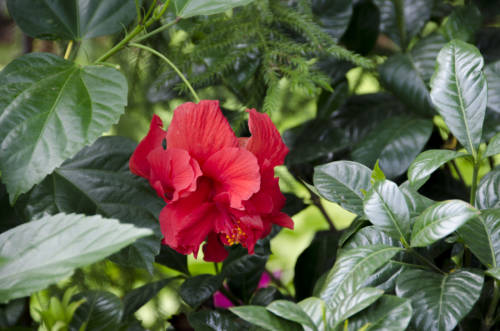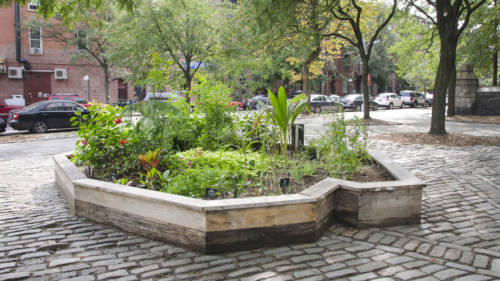
Juanli Carrion’s Geopolitical Garden Is Shaping Globalism in Fort Greene
At first glance, it might be hard to tell that Juanli Carrion’s garden, Outer Seed Shadow Project #2, is a map of Brooklyn’s socio-political landscape.
Visually, the garden, which is nestled in a tiny raised bed in Fort Greene Park, looks like a collage of colors and form, some plants tall and lean, others of the short variety, including: geranium, avocados, tomatoes, and hibiscus all growing side by side.
Upon closer inspection, the 230-square foot garden is the shape of Brooklyn itself, and each plant represents a different country chosen by a representative of an immigrant population that Carrion interviewed. The chamomile symbolizes Russia; the parsley represents Syria, while the corn is from Mexico and Linden trees from Argentina.
For the project, Carrion filmed interviews, which are available on the OSS#2 website, with members from every immigrant population in Brooklyn, asking them to select a plant to represent each. Carrion’s interviews are fascinating explorations of identity, wherein the artist asks probing questions about the meaning of home and the challenges and impossibilities of assimilating to a foreign city. His videos paint an emotional landscape of the realities of immigration.
Carrion began the process in November 2015 by connecting with associations, immigration centers, and individuals to find a representative of each community to interview.
“Upon closer inspection, the 230-square foot garden is the shape of Brooklyn itself, and each plant represents a different country chosen by a representative of an immigrant population that Carrion interviewed.”
Carrion comes from a small town in Spain. Raised by a family of farmers, he had an intuitive relationship with growing plants: the rewards, difficulties, and obstacles involved. After studying art in Valencia and Paris, he moved to New York in 2007 and now resides in Brooklyn, where he is also pursuing a Ph.D. in public art.
Carrion discovered the concept of “outer seed shadow” through researching migration with respect to animals, plants, and humans. The idea, he explained, is that while core seeds from another ecosystem may ravel and grow, they don’t develop or multiply enough to be considered part of the local vegetation.
“They are there. They are present, but they are not represented or considered part of the ecosystem,” Carrion comments. “I thought this was very fascinating in terms of an analogy of different immigrant communities in different cities, where there’s a majority of a culture that’s predominant and how [these communities] interact with each other.”
Bridging his interest in migration with his background in gardening, Carrion began designing geopolitical gardens. “Through these [gardens], you can address almost any social and political issue, and materialize them to make people aware of those conflicts,” he says.
Thinking about form, shape, and color and the different plants and their respective colors, Carrion designed his gardens to be platforms for deeper dialogues that are often difficult to facilitate or sustain.
As his plants grow together, the way they interact with one another is metaphorical. The garden is always changing. For example, when I arrived at “Outer Seed Shadow Project #2” for the first time, the chamomiles were drying out and needed tending, but a week later it was the tomato plants that demanded attention.
“They have been here for three weeks,” Carrion said of the tomatoes. “They are growing very high, but the leaves are not very strong or wide or lush…”
They needed more sun to flourish. “The person who chose the tomato plant is from Aruba, in the Caribbean, and so it’s fascinating how this just happens. The tomatoes asking for more sun can relate with their representative in the interview. You can hear from Brenda that one of more difficult things for her coming here was connected to the weather: the lack of sun, and the cold, and how that affected her life.”
“Through these gardens, you can address almost any social and political issue, and materialize them to make people aware of those conflicts,” Carrion says.
Yet still other metaphors have a darker twist. “Right now we’re going to have currents around the tomatoes. And currents are a very resilient, hardy plant that can actually take over. So I don’t know what’s going to happen. I don’t know if it’s going to affect the growing of the tomatoes or not,” Carrion said. The interactions between plants becomes a vehicle for conversation about history and the relationship between different countries– in this case, France’s relationship with the Caribbean, using currants as a gateway.
The uncertainty with respect to how plants interact are perhaps the main fascination of the project. The interviewees are often more similar to the plants they choose then they realize, for ecological and environmental reasons. The way that the plants interact with each other illuminates their immigration and assimilation experience with subtle but profound dignity.
One of the most important aspects of OSS#2 is a series of educational workshops and activities about gardening that will take place until late October, 2016– including workshops in partnership with local organizations like NYCHA’s Ingersoll and Farragut Gardeners, Maple Street School, and Brooklyn Urban Garden, among others. With special attention paid to the importance of dialogue and propagation of these narratives of immigration, Outer Seed Shadow #2 represents more than just the sum of its plants: it’s a living example of geopolitics and the literal and metaphorical landscapes it shapes.
Outer Seed Shadow #2 is located on the South East corner of the park and will be on view until October 22nd.



































